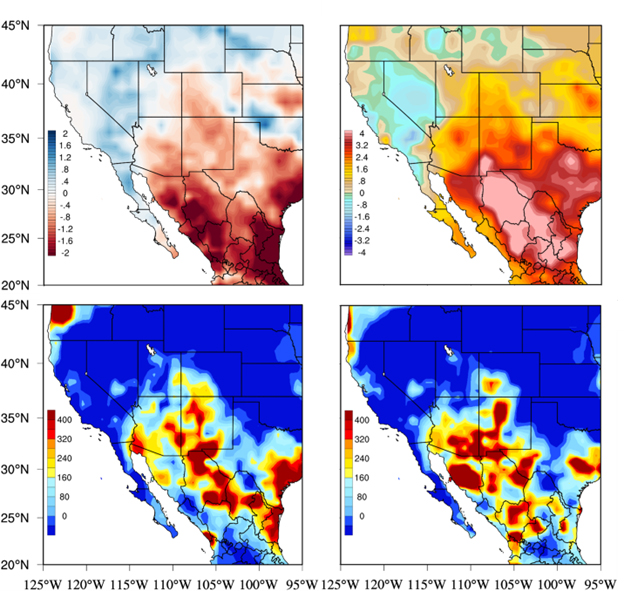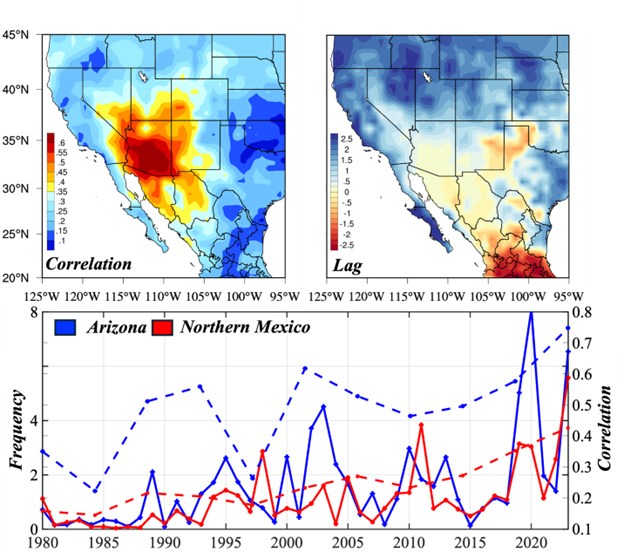
Hot nights during dry times: Measuring “hot droughts”
The summer of 2023 was one for the record books in Phoenix, across the southwestern U.S. and into Mexico, with record-breaking high temperatures on both land and at sea. Residents of the region, including Arizona, endured an unprecedented challenge known as a "hot drought," which affected them both day and night.
The deadly pairing of extreme heat and severe drought can stress our communities, ecosystems and supply chains. But what made the 2023 summer different from previous years, and what exactly is a hot drought?
Understanding hot droughts
A hot drought is when extreme heat and drought occur together, amplifying the effects of each other. Imagine the usual summer heat, but with less moisture in the soil and air.
This lack of moisture intensifies the heat, creating a vicious cycle where the heat worsens the drought, and the drought, in turn, makes the heat even more unbearable. For example, when a heatwave strikes during the day in a region already suffering from drought, the peak temperatures are likely higher because the dry conditions amplify the temperature.
Now here is nature's trick! When the monsoon is delayed or takes a break, intense heatwaves often follow. But what happens when a substantial lack of monsoon rainfall continues?
Moisture is still transported through air, but not enough to rain. At night, instead of cooling down, the heat lingers, amplified by local humidity or moisture brought in from elsewhere, preventing the usual cooling and leaving the land sweltering, and without rainfall.
In Arizona, where summer is already so sunny, adding drought to the mix can turn a tough season into a torturous one.
The hot drought of 2023: A record-breaking event
Along with Enrique Vivoni – pillar lead for the Arizona Water Innovation Initiative and director of the Center for Hydrologic Innovations – I developed an analysis of hot droughts in southwestern North America during summer 2023.
Our research reveals that large swaths of the Mexican Plateau and south Texas experienced significant maximum temperature anomalies exceeding 7.2°F while the Four Corners region recorded anomalies ranging from 1.8 to 5.4°F above average.
In addition, the severity of drought was amplified. Areas along the U.S.-Mexico border, particularly around the Gulf of Mexico, saw the severity of drought increase by 250 to 400 percent, making the 2023 summer three to five times drier than what we typically see.
The combination of extreme heat and drought conditions resulted in hot droughts that were 250 to 300 percent worse than average in Texas, Arizona, New Mexico and parts of Mexico.

The day-night cycle: Impact on urban regions
One of the most troubling aspects of the 2023 hot drought was its persistence through both day and night. Elevated nighttime temperatures disrupt the natural cooling of the land surface. This disruption can exacerbate drought and heatwave conditions by increasing evaporation and extending low soil moisture levels and elevated temperatures over many days.
These extended hot drought conditions are likely during the monsoon season when the usual nighttime cooling is compromised by increased monsoon humidity. You might wonder how it can feel humid even when we're in the middle of a drought.
Well, it turns out that during droughts, the way the atmosphere works gets a little unusual. Normally, rain forms when water vapor condenses, but large-scale weather patterns like winds and pressure systems can shift unpredictably during a drought.
These changes often prevent moisture in the air from turning into rain. So, even though it feels humid, the moisture doesn’t always result in rainfall. That’s why you can still experience humidity during a drought—nature doesn’t always follow the usual rules!
This humidity, combined with winds that bring warm air from other regions, means that the nights are almost as hot as the days.
The influence of nighttime heating is more prominent over urban regions. In Phoenix, average July-September nighttime temperature anomalies were even higher than the daytime, indicating that nights stored heat rather than dissipated it. This effect spilled the stored heat over into subsequent days.
This is partly due to the urban heat island effect, where cities, with their concrete and asphalt, retain heat longer than rural areas. This relentless nighttime heat in Phoenix was made even worse by the drought, leading to severe nighttime hot droughts.
The science behind the severity: What made 2023 different?
Several factors contributed to the amplified severity of the 2023 hot drought. One of the most significant was the North American monsoon. The monsoon usually brings much-needed rain to the region from July to September, helping to ease the summer heat.
In 2023, the monsoon was much weaker than usual, especially in northern Mexico and the Four Corners region, leading to widespread drought. The lack of rain, combined with the intense heat, created the perfect conditions for a hot drought.

Here, it's important to note that 2023 was an El Niño year, which often leads to drier conditions in Northwest Mexico. In contrast, Arizona and New Mexico usually have a weak connection between dry summers and La Niña.
Our research also revealed a cross-border atmospheric interaction where nighttime hot droughts in northern Mexico often preceded daytime hot droughts in Arizona by one to three weeks. This means that the hot droughts from northern Mexico are being transported northward, exacerbating the extreme conditions in Arizona.
Furthermore, in the span of 2019-2023, the magnitude of this atmospheric interaction nearly quadrupled from how it was between 1980 and 1984. This evidence suggests a connected regional pattern, where hot droughts in one area are more likely to influence or coincide with hot droughts in neighboring regions.
Our work indicates that hot droughts need to be analyzed over day and night and over regions that are connected by their precipitation patterns to improve their prediction, response and mitigation.
Related stories: